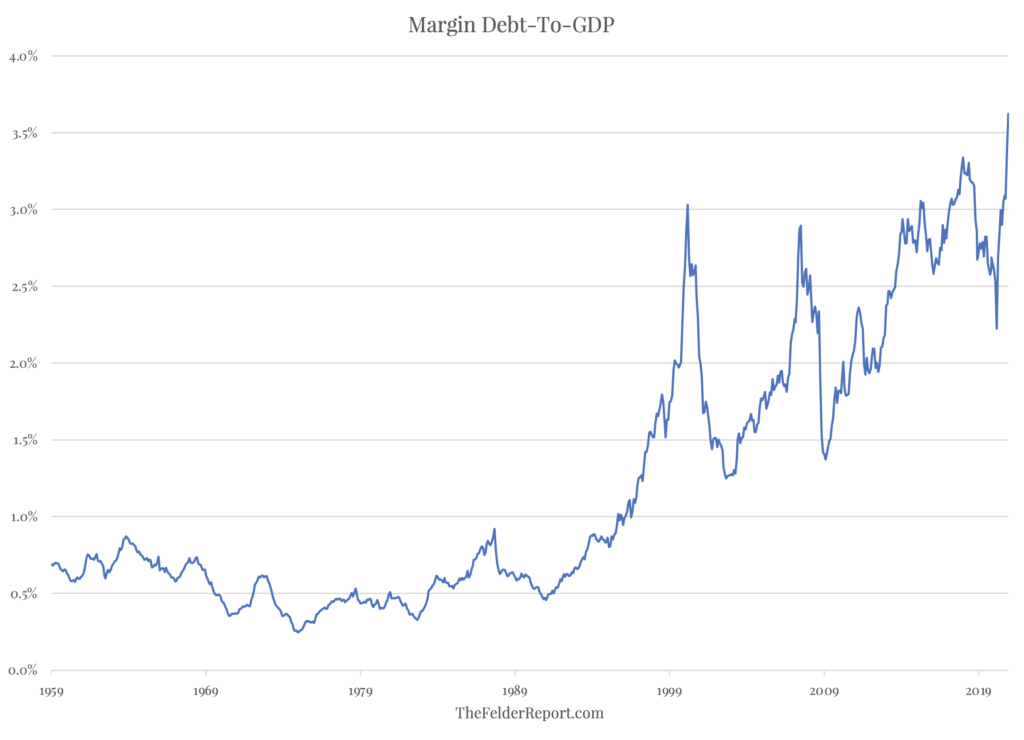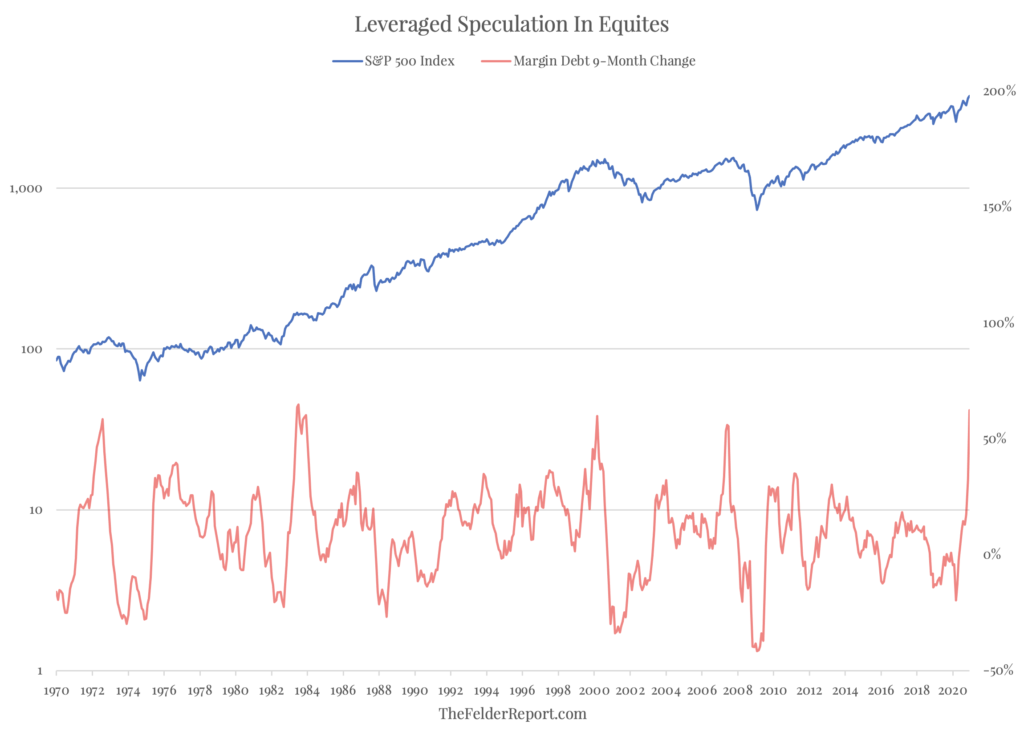Timing & trends
“Even the most circumspect friend of the market would concede that the volume of brokers’ loans—of loans collateraled by the securities purchased on margin—is a good index of the volume of speculation.” -John Kenneth Galbraith, The Great Crash 1929
There are all sorts of signals pointing to rampant speculation in the stock market today. And if we are to measure it by way of margin debt (normalized by the size of the economy), then what we are witnessing is, in fact, a level of speculation that dwarfs anything seen in modern times.
Not only is the overall level of margin debt hitting new highs, the 9-month increase in the total amount of margin debt also just soared to a new record. It’s hard to believe that both of these could be possible simultaneously, that off of such a massive base the amount of debt used to speculate could increase so rapidly, but there you have it.
Close observers of the chart above will notice two things: first, when margin debt has soared in the past like it just did, it almost always coincides with a major stock market peak (see: 1972, 2000 and 2007 – 1983 was the exception and when you consider that valuations were extremely cheap at the time and margin debt was coming off relatively miniscule base it’s not hard to see why the correction following that increase was relatively muted.)
Second, the bear markets following these surges in margin debt were, to some extent, driven by a natural deleveraging process that took the 9-month change deep into negative territory. In other words, the boom sows the seeds of its own bust.

If you’ve been following the news, you are probably aware that there are a few stocks right now– most notably GameStop (GME), that have soared to incredible heights in a matter of days, thanks to a zealous group of individual investors on reddit and TikTok.
These aren’t titans of finance; they’re a bunch of little guys, many of whom are also frustrated by the rigged financial system.
A bit of background– GameStop is a company that sells video games. And, for years, almost all of their sales have been from their 5500+ stores around the world.
That business model worked really well… in 2005.
Today, most users download video games online directly from the publishers, or they stream games from Google, Amazon, Apple, or Steam. Going into a store and buying a DVD is a thing of the past, and GameStop’s sales have suffered as a result of this trend.
A handful of hedge funds have been betting that GameStop will go out of business soon, or at least that the stock price will continue to decline.
So these funds shorted the stock in a huge (and dubious) way, selling more shares of the company than were actually in existence.
And a number of small investors saw these questionable short positions and said, ‘Enough is enough. We’re tired of hedge funds exploiting the market.’ So they’ve banded together and bid up the price of GameStop’s stock to absolutely epic levels.

There is little need to tell you that markets are, and will continue to be, VOLATILE, as geopolitical and financial upheavals continue. This does not mean that there are few opportunities for the savvy investor. Now is the time for all investors to employ a broader range of strategies to anticipate, respond to, and capitalize on market volatility.
So, what needs to be included in a broad and robust investing strategy? The answers may surprise you, as many investors typically put too many of their eggs in one basket, hoping they will hatch into substantial gains. Hope is not a strategy, and this helps to explain why most investors do not make gains in…Click for full article.

The institutional herd has arrived to the Bitcoin market as institutional platforms see record-high volume. The daily volume of the CME Bitcoin (BTC) futures market and LMAX achieved a new all-time high on Jan. 4. The data show that the institutional demand for BTC is rapidly surging as major public funds continue to accumulate.
Institutional appetite for Bitcoin is accelerating
According to analysts at Arcane Research, the daily volume of LMAX Digital reached a record-high at $2.62 billion.
LMAX is a trading platform that tailors to institutional and accredited investors, unlike retail-focused platforms such as Coinbase and Binance

Let’s review the years in which January failed to carry through from the “Santa Rally.”
The first two examples, 2001 and 2002, were in the midst of the “Dot.Com” crash, so that we can write those off to a bear market. The same goes for 2009.
However, 2010 is a bit different as the economy had started a recovery, earnings growth was strong, and the Federal Reserve was amid QE-1. Yet, January had a -3.7% rate of return following the “Santa Rally.” Other than the “Haiti Tsunami,” there was no other major event causing stocks to decline except “exhaustion” after a 10-month uninterrupted advance.
In 2013, January also posted a negative return. The concern of the “fiscal cliff,” as the comprise to lift the “debt ceiling,” required a bipartisan group of Congressman to find $1 Trillion in budget cuts. Their failure to find cuts triggered an automatic set of cuts across agencies. Fed Chairman Ben Bernanke launched QE3 a month before to offset the impact of the “fiscal cliff.” However, given the cuts never materialized, the Fed’s flood of liquidity caused a surge in stocks over the rest of the year.
The beginning of 2020 also posted a negative January return following an incredible rally in 2019. More like 2013, the market’s extension was extreme with a near-record number of stocks above their 200-dma. The market needed to correct before continuing its advance to all-time highs in February.
January 2021 has a lot of similarities to both 2013 and 2019. With the Federal Reserve continuing QE and a near-record number of stocks above their 200-dma, and an extreme bullish bias, the risk of a correction exists. A government shutdown, stalled stimulus bill, or a surge in virus cases could do the trick.














